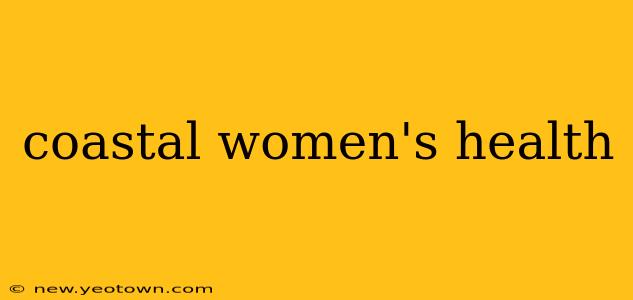The ocean's rhythmic pulse and the salty air—these are the hallmarks of coastal living. But for women residing in coastal communities, life presents a unique set of health challenges, often intertwined with the very environment they call home. This isn't just about sunburns and saltwater stings; it's about a complex interplay of environmental factors, access to healthcare, and lifestyle choices that profoundly impact women's well-being. Let's dive into the specifics.
What are the unique health concerns for women living in coastal areas?
Coastal living presents a fascinating blend of benefits and drawbacks for women's health. While the fresh air and stunning scenery are undeniably appealing, several specific factors can influence health outcomes:
-
Increased Sun Exposure: Living near the coast often means more time outdoors, increasing the risk of sun damage, skin cancer, and premature aging. The reflective nature of sand and water intensifies UV radiation, making sun protection crucial.
-
Occupational Hazards: Many coastal economies rely on industries like fishing, tourism, and maritime work. These occupations can expose women to physical hazards, heavy lifting, irregular hours, and potential injuries.
-
Water Quality and Exposure: Access to clean water and sanitation isn't universally guaranteed in all coastal regions. Exposure to contaminated water can lead to various infections and illnesses. Additionally, some coastal areas experience higher rates of waterborne diseases.
-
Access to Healthcare: Depending on the location, access to specialized healthcare, particularly for women's health issues, can be limited in some coastal communities. Geographical isolation and a lack of transportation can create significant barriers to timely and adequate care.
-
Mental Health Considerations: The isolation experienced by women in some coastal areas, combined with potential economic hardships associated with seasonal work or natural disasters, can significantly impact mental well-being.
What are some common health problems faced by women living in coastal areas?
Coastal women, like all women, face a range of health concerns. However, certain conditions may be more prevalent or exacerbated by coastal living:
-
Skin Cancer: The increased sun exposure significantly elevates the risk of skin cancers, including melanoma. Regular skin checks and sun-protective measures are vital.
-
Respiratory Illnesses: Exposure to allergens like pollen and pollutants carried by sea breezes can trigger or worsen respiratory problems like asthma and allergies.
-
Musculoskeletal Issues: Jobs involving repetitive movements or heavy lifting in industries like fishing and tourism can increase the risk of musculoskeletal disorders such as carpal tunnel syndrome and back pain.
How can coastal women improve their health?
Proactive health management is particularly important for coastal women. Here are some key strategies:
-
Sun Safety: Regular use of high SPF sunscreen, protective clothing, and seeking shade during peak sun hours are essential.
-
Regular Health Screenings: Scheduling routine checkups and screenings for skin cancer, cervical cancer, and other health concerns is crucial.
-
Healthy Lifestyle Choices: Maintaining a balanced diet, engaging in regular physical activity, and prioritizing stress management are vital for overall well-being.
-
Seeking Support: Connecting with local support networks and utilizing available mental health resources can help address stress and isolation.
-
Advocating for Access: Participating in community initiatives and advocating for better access to healthcare and resources is crucial for improving the health of coastal women collectively.
What resources are available to coastal women for their health needs?
While access to resources can vary, several options might exist depending on your location:
-
Local Health Clinics: Many coastal communities have local health clinics offering basic healthcare services.
-
Telemedicine: Technology can bridge geographical gaps, enabling access to specialists through telemedicine consultations.
-
Community Health Programs: Various organizations run community health programs focused on women's health in coastal areas.
Are there any specific health risks for women who work in coastal industries?
Women working in coastal industries face unique occupational hazards. These may include:
-
Physical Injuries: Risks of falls, cuts, strains, and other injuries are higher in physically demanding roles.
-
Exposure to Hazardous Materials: Depending on their specific job, women might be exposed to chemicals, pollutants, or other hazardous materials.
-
Ergonomic Issues: Repetitive motions and poor posture can lead to musculoskeletal problems.
Addressing these risks requires proper safety training, protective equipment, and ergonomic workplace designs.
Coastal living offers a unique lifestyle, but it also presents specific challenges to women's health. By understanding these challenges, taking proactive measures, and advocating for better access to healthcare and resources, coastal women can prioritize their well-being and thrive in their beautiful, yet demanding, environment.

